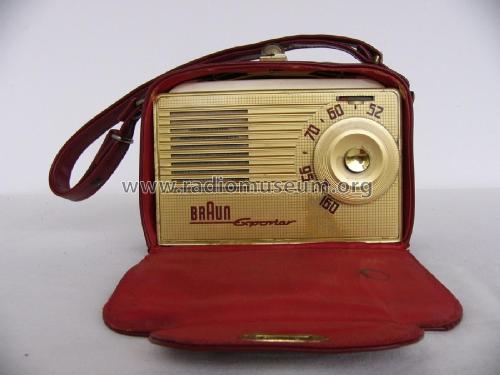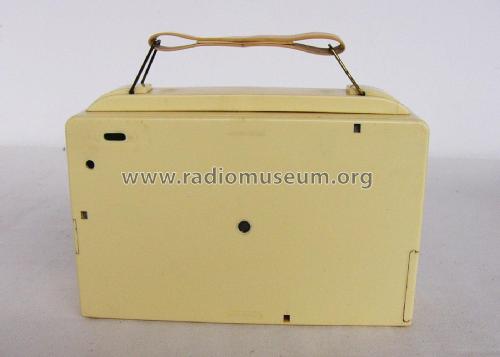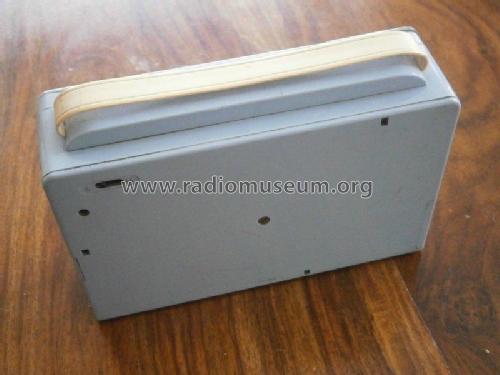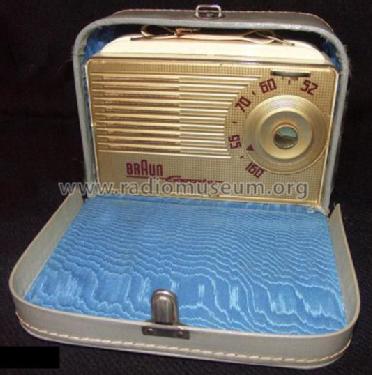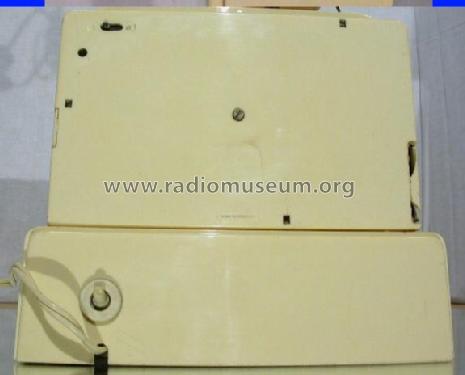Exporter - Exportar LW & MW
Braun; Frankfurt
- País
- Alemania
- Fabricante / Marca
- Braun; Frankfurt
- Año
- 1956/1957 ?
- Categoría
- Radio - o Sintonizador pasado WW2
- Radiomuseum.org ID
- 139231
- Numero de valvulas
- 4
- Principio principal
- Superheterodino en general; ZF/IF 460 kHz; 2 Etapas de AF
- Número de circuitos sintonía
- 6 Circuíto(s) AM
- Gama de ondas
- OM y OL
- Tensión de funcionamiento
- Pilas / 1,5 & 50 Volt
- Altavoz
- Altavoz dinámico (de imán permanente) / Ø 7 cm = 2.8 inch
- Potencia de salida
- 0.08 W (unknown quality)
- Material
- Plástico moderno (Nunca bakelita o catalina)
- de Radiomuseum.org
- Modelo: Exporter - Exportar [LW & MW] - Braun; Frankfurt
- Forma
- Portátil de bolsillo , menor de 20cm.
- Ancho, altura, profundidad
- 175 x 120 x 50 mm / 6.9 x 4.7 x 2 inch
- Anotaciones
-
Heißt das Gerät nun "Exportar" (siehe Abbildungen und Schaltbild)?. Oder wie z.B. im Katalog "Exporter"? Die Schrift ist nicht eindeutig.
Ausführung mit Bereichsumschalter L-M auf der Rückseite; Gehäusefarbe elfenbein (goldfarbene Front) oder pastellblau (silberfarbene Front).
Dazu passend auch der optionale Netzuntersatz NAG 250 (DM 29,50) in gleicher Farbe.
Gegen Aufpreis war ein passender Lederkoffer für das Radio erhältlich. Chassis: KL1;
Schema: siehe Exporter 2.
- Peso neto
- 1.1 kg / 2 lb 6.8 oz (2.423 lb)
- Documentación / Esquemas (1)
- -- Original-techn. papers.
- Autor
- Modelo creado por Günther Stabe † 19.8.20. Ver en "Modificar Ficha" los participantes posteriores.
- Otros modelos
-
Donde encontrará 1068 modelos, 938 con imágenes y 655 con esquemas.
Ir al listado general de Braun; Frankfurt
Colecciones
El modelo Exporter - Exportar es parte de las colecciones de los siguientes miembros.
Contribuciones en el Foro acerca de este modelo: Braun; Frankfurt: Exporter - Exportar
Hilos: 1 | Mensajes: 4
Hello!
A friend of mine has recently acquired two Braun "Exporter" radios, which are causing him some concern. The radios are only marked in medium-waveband frequencies, but yet they have a chassis capable of receiving long- and medium-wave stations and have a switch for this. They are of the original gold/red design as opposed to the later Exporter 2 (Rams?) design.
Can anybody explain why the sets should be made like this? Any help would be greatly appreciated.
Regards,
Mike.
Mike Izycky, 30.May.04
